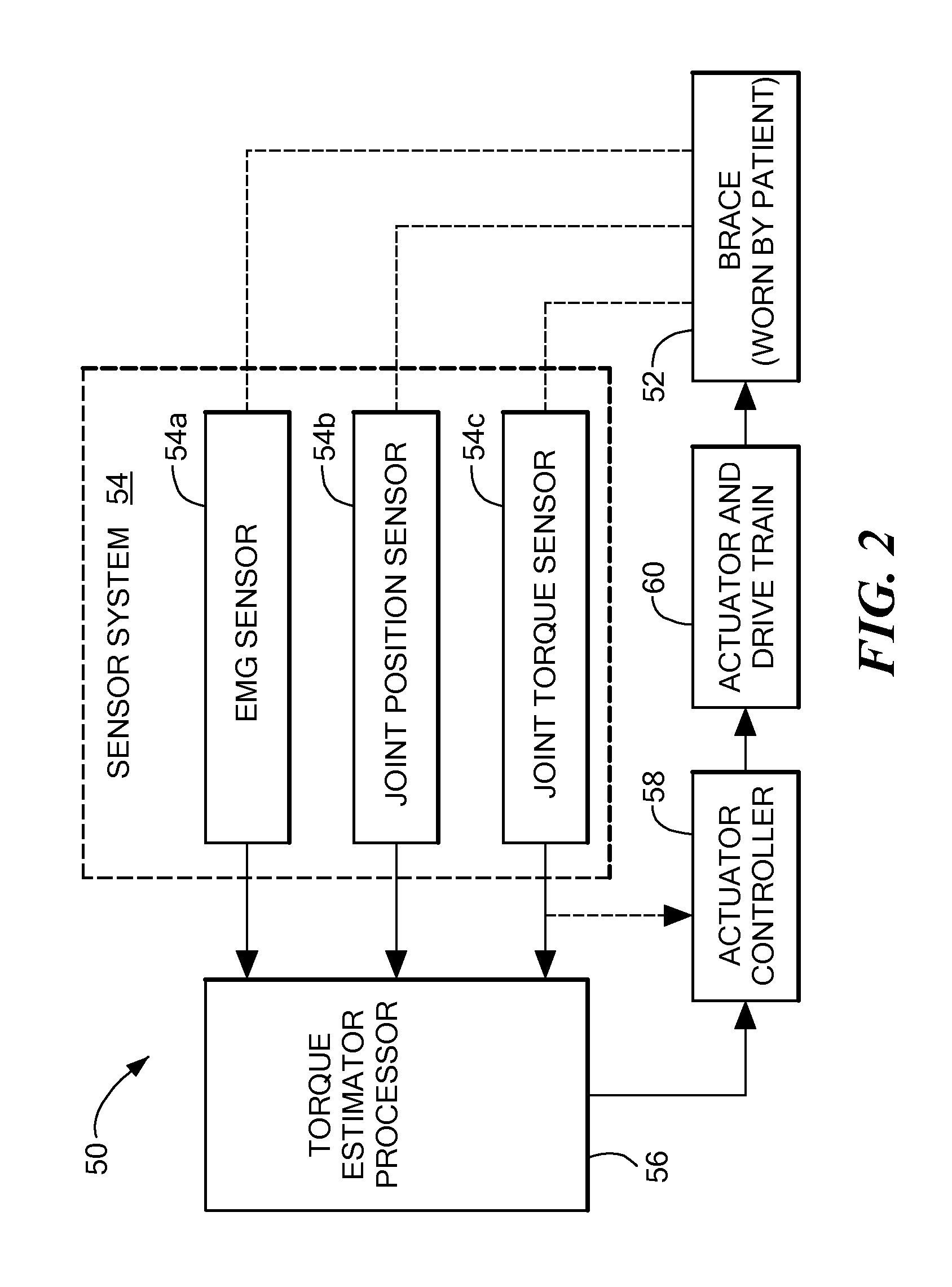[0008] In accordance with the present invention, a powered
orthotic device that is worn by and physically controlled by a patient suffering from neurological trauma, spinal cord or other nerve damage including
stroke or neuromuscular disorder (e.g.,
muscular dystrophy, myotonias, myopathies or other congenital disorders) or a patient requiring general
rehabilitation services or strength increase includes a brace to be couple to a desired body part, a sensor which senses an electrical signal at a
muscle which is usually
proximate the body part and an
actuator coupled to receive a signal from the sensor and to provide a force having a magnitude which is proportional to a magnitude of the sensor signal. The sensor senses or otherwise determines a desired joint torque and the
actuator applies a proportional amount of torque in parallel with the torque provided from the patient's own muscle. The sensor may include an integrated processor which utilizes signals produced by the sensor or alternatively the processor may be separate from the sensor. With this particular arrangement, a patient-worn which device provides the patient with an ability to control the limb or body part affected by spinal cord or other nerve or muscular damage more rapidly than previous therapy methods is provided. Since the powered orthotic device allows the patient to control an affected body part, the patient is able to more rapidly leave a hospital or other institution. Also, in cases where full rehabilitation is not possible, the patient can continue to use the powered orthotic device to perform
activities of daily living. Also for patients with
spasticity and tremor, it is possible to filter or extract the meaningful information from the user and reject the “
noise” associated with the user's input, enabling them to smoothly move a spastic limb or body part. For patients that suffer from co-contraction it is possible to have the weaker, patient controllable,
muscle group overpower the stronger, uncontrollable opposing muscle. Thus, in general the orthotic device could discern a patient's intent, despite co-contractions. The powered orthotic device of the present invention thus corresponds to a wearable, unencumbering
exoskeleton that augments human physical capability by working in parallel with existing musculature. The device of the present invention both augments strength and can accelerate rehabilitation in people who have suffered from neurological trauma or neuromuscular disorders, or a general loss of strength.
[0011] With this particular arrangement, the powered orthotic device can be controlled by a patient having spinal cord or other nerve damage, including stroke, by way of the EMG signal generated by the patient, to bend or otherwise move a joint or body part which the patient is otherwise unable to effectively move. In this way, the patient can be quickly rehabilitated to use their limb or body part, or can use the powered orthotic device for daily activities where rehabilitation is not fully possible.
[0012] In one embodiment, a wearable, powered, orthotic device that provides external assistance to enable a user to move in a desired motion is provided. The powered orthotic device provides increased strength for victims of degenerative neuromuscular conditions as well as other conditions. The device is worn by a user (e.g., in the form of a sleeve or a brace-type structure) and includes sensors which sense an electromyogram (EMG) signal generated by flexor and extensor muscles of a joint. The signals are processed to determine the user's desired joint torque and that information is provided to a
control system. The
control system adds a proportional amount of assistance to the user via a force provided to the user's limbs, for example, by a relatively light weight,
actuator. This approach provides a relatively compact, inexpensive
system. In some embodiments, all components of the
system (including the actuator and power supply) are worn by the user. In this case, the device is fully portable. In such a fully portable embodiment, it may be preferable to provide the power supply as a relatively lightweight power supply. Relatively high
mass components of the device can be mounted on the brace or a portion of the user's body in manner which does not impede the user's ability to move. Alternatively still, in another fully portable embodiment, relatively heavy components of the
system (e.g., the actuator and power supply) may be worn by the user in a hip pack or other support structure. Such a support structure is preferably coupled to the user to support at least some components of the orthotic device while still keeping the orthotic device fully portable. At the same time, the support structure is provided so as not to add any additional
mass (or a resistive force) to the limb or other body part to which the orthotic device is providing assistance. In other embodiments, an external power supply (e.g., the power supply from a
wheelchair or other external device) can be used in which case portability depends upon the portability of the external power supply. Likewise, an actuator which is physically supported by an external structure other than the orthotic device or by the user (e.g., a
wheelchair) can also be used. Again, in this case portability depends upon the portability of the external actuator.
[0013] By providing a device which is lightweight, portable, and wearable able, the device enables the wearer to carry on routine activities such as eating,
personal hygiene, or controlling a
wheelchair. One benefit is that the user will be able to use, and potentially retrain affected limbs following incidents such as stroke, incomplete spinal cord injuries, etc. The device also allows rehabilitation to be accomplished through the execution of daily tasks, decreasing the need for lengthy therapy sessions which are costly in terms in terms of effort, money and human resources.
 Login to View More
Login to View More  Login to View More
Login to View More 


